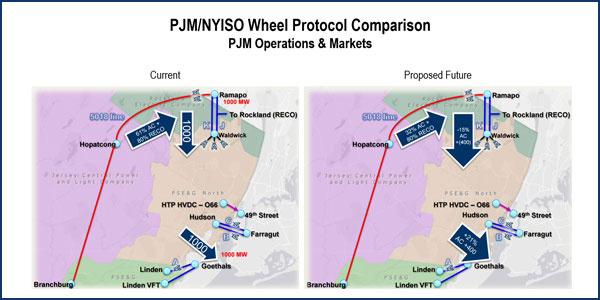By Robert Mullin
FERC on Thursday rejected a request to rehear its October 2017 ruling approving changes to the PJM–NYISO joint operating agreement reflecting a new operational plan for the ABC and JK interfaces between New York and New Jersey (ER17-905).
PJM and NYISO developed the JOA interchange scheduling and market-to-market (M2M) coordination provisions after Public Service Enterprise Group and Consolidated Edison terminated a wheeling arrangement that facilitated the flow of energy between congested areas in southeastern New York and northern New Jersey.
The revisions combined NYISO’s ABC and JK interfaces with the 5018 line and PJM’s western ties, creating an aggregate PJM-NY AC proxy bus. The grid operators said the changes would make use of existing interchange scheduling constructs and support the phase angle regulators on the interfaces. Pricing on the proxy bus was expected to reflect the impacts of imports and exports on the NYISO and PJM transmission systems, weighted by power flow distribution percentages. (See Rejecting PJM ‘Wheel’-related Requests, FERC Sets Inquiry.)
In approving the changes, the commission rejected a complaint by PSEG that the changes infringed on the rights of transmission owners and there was no reliability need for the 400 MW of operational base flow (OBF) provided by the arrangement. FERC instead said it recognized the OBF was necessary to address reliability concerns in northern New Jersey and to avoid additional power from being forced over the western ties and increasing flows over already congested transmission facilities.
In its Thursday decision, FERC denied a rehearing request by PSEG and the New Jersey Board of Public Utilities, saying the complainants were incorrect in their contention that the commission erred in approving JOA revisions that failed to allocate PJM Regional Transmission Expansion Plan costs to New York beneficiaries of the OBF arrangement.
FERC noted that PSEG concedes that the JOA “is an operational protocol and that it does not appear to meet the definition of firm point-to-point transmission service, transmission service or similar terms under the PJM or NYISO Tariffs.” Instead, the commission, said, the OBF is an operational protocol “that expressly does not provide firm transmission service and does not allocate costs to an entity like Con Ed.”
“This materially distinguishes the JOA from the now-terminated [wheeling transmission service agreements] to which Con Ed was a party and under which Con Ed was allocated costs due to its firm transmission service on both the NYISO and PJM systems,” the commission wrote.
FERC also disagreed with PSEG’s contention that the commission was wrong to rely on PJM and NYISO analysis showing the OBF was needed to maintain reliability. PSEG had argued the analysis was flawed because it combined an assumption of congestion during summer peak conditions with a level of interchange — 2,500 MW — that would never occur during the summer.
“PSEG does not address NYISO’s and PJM’s explanation that there were hours between 2014 and 2016 during which the net interchange between PJM and NYISO exceeded 2,500 MW. It was therefore reasonable for the commission to rely on PJM’s studies for demonstrating actual historical flows and a reasonable net interchange value,” FERC said.
The commission also said it found “unpersuasive” PSEG’s assertion that NYISO and PJM should rely on existing NERC transmission loading relief procedures instead of the OBF.
“As the commission explained in the October 2017 order, the NERC procedures are a less economically efficient outcome compared to the RTOs’ proposal to implement economic interchange over the ABC interface and JK interface and also utilize M2M PAR coordination at these interfaces,” FERC said. “PSEG does not disagree that transmission loading relief procedures are out-of-market mechanisms, and that in PJM they are specifically emergency in nature and in NYISO are used when necessary for maintaining reliability in NYISO.”




